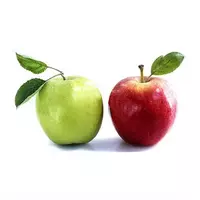Apple

It would seem that everyone knows about apples and that's it. But at the same time, this fruit, which is well known to each of us, remains one of the most mysterious, because numerous information about it gives rise to confusion and confusion, many rumors and myths. Therefore, it's time to figure out what we actually know about apples and what can be considered the truth.
The birthplace of apples is Central Asia, the territory of present-day Kazakhstan and Kyrgyzstan. In these areas, the apple tree is still found in wild form. From there began a grandiose and victorious procession of apple trees around the world. Now it is difficult to imagine an area where apples would not grow or be eaten.
This is such a popular fruit that it is very difficult to talk about its culinary application. The apple can be used in the preparation of almost any dish, ranging from meat dishes to all kinds of desserts. And each of them will give the apple a unique taste and amazing aroma. The calorie content of the apple is 47 kcal. per 100 gr.
It is one of the most popular dietary foods, including apples in almost all diets. It is believed that green apples contribute best to weight loss, but in fact the beneficial properties of apples of various varieties (of which, by the way, there is an indescribable amount) are approximately the same.
Apple varieties
The most common apple varieties most commonly used in our country for culinary purposes include:
Apples Ranetka
Apples golden
Apples White Pour
Antonovka apples
Apples Aydared
Jonagold Apples
Gloucester Apples
Melba apples
Apples Mantet
Gala Apples
Apples Bogatyr
Apples of Medunica
Apples Chinese
Granny Smith Apples
Apple Lobo
Florin's Apples
Apples Glory to the winners
Apples Grushovka
Apples Jonathan
Apples Anis
Apples Mackintosh
Pepin Apples
Fuji Apples
Apples Spartan
Apple benefits
The composition of the apple is indescribably rich and diverse. In particular, vitamins B, C, E, PP, as well as potassium, iron, calcium, magnesium, iodine are present in the apple. It is noteworthy that during storage, the amount of useful substances in the apple decreases very slightly, so the apples of even last year's harvest are very useful. In addition to these components, the apples contain fiber, starch, tannins and pectins.
All this determines the benefits of the apple for all systems of the body. For example, the positive effect of apples on the cardiovascular system is expressed in their ability to strengthen the walls of vessels, increase their elasticity and permeability.
Apples have a mild laxative and diuretic effect. This explains the benefits of the apple for the gastrointestinal tract and urinary system. Substances contained in apples have the ability to bind harmful and toxic substances and remove them from the body.
Apple is considered a natural antioxidant, so regular consumption of apples contributes to the prevention of many viral and infectious diseases. The availability of apples makes them almost indispensable for the prevention of spring vitamin deficiency.
Apple harm
However, for all the benefits of the apple, you need to remember about the contraindications that its use has. First of all, the harm of an apple can manifest itself when it is overused as the basis for a monodiet. A large amount of fiber can cause disorders in the gastrointestinal tract, especially if ulcers, gastritis, colitis are already present.
Negatively, apples can affect the condition of tooth enamel, when used excessively, apples cause it to thin. In addition, experts warn that apple bones contain hydrocyanic acid, which is considered a poisonous substance.
apple 47 kCal
The energy value of an apple (Ratio of proteins, fats, carbohydrates - ju):
Proteins: 0.4 g (~ 2 kCal)
Fats: 0.4 g (~ 4 kCal)
Carbohydrates: 9.8 g (~ 39 kCal)
Energy ratio (bj | y): 3% | 8% | 83%
 Español
Español Français
Français Português
Português Русский
Русский 简体中文
简体中文 繁體中文
繁體中文 日本語
日本語 한국어
한국어 العربية
العربية Türkçe
Türkçe Қазақ
Қазақ Deutsch
Deutsch Italiano
Italiano Українська
Українська
